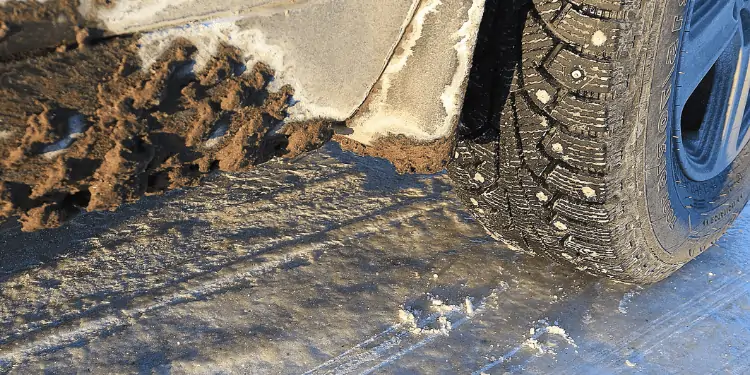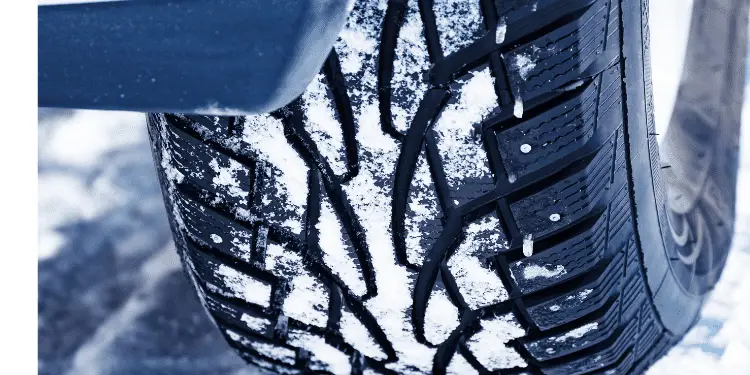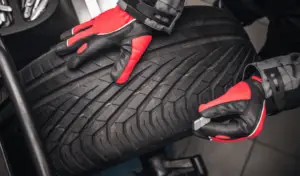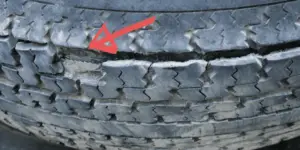As you are well aware studded tires are more expensive than winter tires but perform much better at lower temperatures.
Studded tires are great when we need to drive, but the weather is dangerous to the extreme. How fast can you drive, though?
Most studded tires have speed ratings of up to and above 100 mph. However, driving on snow is the major purpose for studded tires. Generally, you shouldn’t drive more than 40 mph in these conditions. Also, studded tires need to be broken in.
In this post, we’ll examine the speed you should travel in different weather conditions using studded tires.
Studded tires have speed ratings, but these are not aligned with the maximum speed recommended with snow or ice on the road. They are the maximum speed the tires are designed for in normal driving conditions.
Where winter tires may struggle to grip in extreme icy conditions, these tires, with their added studs, take compacted snow in their stride. They also stay supple at lower temperatures where all seasons would become less pliable.
However, they can give drivers a false sense of safety and result in going at extreme speeds the studs can fail to grip at.
Let’s look at this in more detail
Compact Snow Maximum Speed
Studded tires are designed to be used in compacted snow and ice. When fitted, studded tires can allow you to drive at much faster speeds than normal.

Often the studded tires have the same compound as winter tires. The only difference is the addition of studs on the tread surface.
With that being said, as a general rule, you should be able to travel at much higher speeds with studded tires and with greater safety.
Talking about safety brings us to another important consideration for studs.
Compact Snow Braking Distances
This is where the differences between studs and no studs are measurable
A test at 30 mph comparing studded and non-studded winter tires of the same brand on the same make of car found that non-studs tires took double the distance to stop compared to the car with studs.
Here’s a great video showing the test.
No Snow Maximum Speed
It’s not a good idea to drive with studded tires when there’s no snow on the road.
With no snow present, you can drive your car up to the tire’s speed rating, at least in principle. The big downside of driving on clear roads at speed is the studs will wear out quickly as they heat up against the road.
No Snow Braking Distances
Studded braking distances are comparable with non-studded tires. It makes no sense to use studs without snow. The friction and heat will increase on the studs and wear them out very quickly.
In states with patchy snow days and infrequent ice, winter tires without studs would be a far better and cheaper option.
Ice Maximum Speed
Because ice is essentially compacted snow, the same precautions apply as with the advice given already.
There is no such thing as a one size fits all driving speed; there is only the speed that tire manufacturers advise. That’s to drive in accordance with the road and the weather conditions.

Ice Braking Distances
Please refer to the compacted snow answer above, as ice and compacted snow are very similar.
Can I Use Studded Tires In My State?
Good question!
There is no country-wide stipulation in the United States. During periods of expected severe weather, a state may mention that studded tires should be used by this isn’t usually the law.
Here is a list of state laws around this question. As you’ll see, each state has different regulations. Some will allow studded tires between October to March with no restrictions. Others will stipulate certain weather conditions need to be present.
Some states make it compulsory in some of their more mountainous counties that studs are mandatory on vehicles over a certain weight.
Many visitors read this article next: How Fast Can You Go With Studded Tires?
How Long Do Studded Tires Last?
Three factors will dictate how long your studded tires last
- How frequently are you using them? Studded tires will last the same amount of time as non-studded tires.
- The studs aren’t designed to be used all through the year. They’ll almost always need to be replaced in the fall if used during summer. It’s probably against state laws to use them where there is no snow on the road.
- All tires driven on gravel roads daily will wear out faster than those driven on paved roads. Studded tires are no exception. The more miles you drive off-road, the more likely you will encounter a pothole or get pierced by a sharp shard of gravel.
How Often Should I Check My Studded Tires?
Studded tires do not require particular attention or maintenance if driven at the correct time of year on compacted snow or ice.
Take a look around your car every week for any sharp tacks, nails, or sharp stones, and remove them. Check for scuffs along the tread on the tire wall because this signals low tire pressure. Make sure you haven’t lost too many studs.
Finally, get a tire pressure gauge and measure the pressure. The PSI required by each tire manufacturer differs. Generally, the colder the weather, the greater the pressure required for studded tires, with a 1 PSI increase for every 10 degrees Fahrenheit drop in temperature commonly mentioned.
Many visitors read this article next: How Fast Can You Go With Winter Tires?
Do You Need Studded Tires On All 4 Tires?
Yes. It might be cheaper to put studded tires on the axle that provides the drive while leaving all-season tires on the other two wheels.
But resist the temptation.
This will result in one-half of your car performing well. This is less obvious when going straight in dry weather, but whenever you need to stop or react quickly in snow, your car may act unpredictably.
What’s The Difference Between Winter and Studded Tires?
Studded tires outperform winter tires in compacted snow and ice as they give better traction.
Winter tires work better in the cold, wet, and slush. That being said, studded tires are always preferable to all seasons tires in the winter.
A downside of studded tires is they are more expensive, aren’t always allowed on highways in certain states, and will have to be changed to all seasons as soon as the snow retreats in the spring.
In conclusion
Most studded tires are rated for speeds of up to and in excess of 100 mph. However, the primary use of studded tires is for driving on snow. In general, you shouldn’t go faster than 40 mph while driving in these circumstances. Secondly, studded tires require breaking in.



![How Fast Can You Go With Chains on Your Tires? [Answered] snow-chain-frozen](https://carzaza.com/wp-content/uploads/2023/12/snow-chain-frozen-300x150.png)









